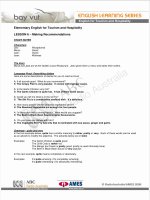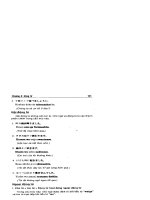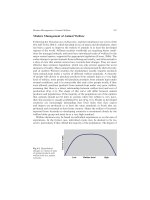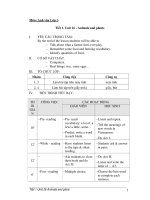WorkbookEdition 6 island animals
Bạn đang xem bản rút gọn của tài liệu. Xem và tải ngay bản đầy đủ của tài liệu tại đây (179.13 KB, 4 trang )
READTHEORY
Passage and Questions
Name________________
Date________________
• Reading Comprehension Assessment
Directions: Read the passage. Then answer the questions below.
Island Animals
The Galapagos Islands are home to many strange and
wonderful animals. But people are prohibited from living on the
islands. No people live there—only animals do. And the animals
that live there are very unusual. They are not like the animals you
might see at home. In fact, they are unlike the animals you might
see any other place in the world.
One interesting animal that lives on the islands is the
Marine Iguana. This is a special kind of Iguana. You see, iguanas
look like big lizards. They can be over five feet long! And,
surprisingly, most Iguanas cannot swim. But Marine Iguanas
know how to swim. They are the only ones that can. This is what
makes them special. And they only live on the Galapagos Islands.
Another unusual animal living on the islands is the Giant Tortoise. A Tortoise is a turtle that lives
only on land. And these tortoises really are giant. They can weigh over 500 pounds! And they can live
longer than people can. They can live for up to 150 years!
The Tortoises are not the only big creatures on the islands. The islands also have Fur Seals and
Sea Lions. Like the tortoises, the Fur Seals and Sea Lions can also weigh over 500 pounds. And they are
both excellent swimmers. Some people have trouble telling them apart. That's because they look a lot like
each other. The main difference is the Fur Seals have thicker fur, like a very furry dog.
In addition to the animals described above, the Galapagos Islands are home to the Flightless
Cormorant. The Flightless Cormorant is a very strange bird. It has wings but cannot fly! That's because its
wings are too small for flying. But even though it can’t fly, it can do something else. It can swim! It can
even swim down to the ocean floor in search of food.
As you can see, the Galapagos Islands are home to some pretty interesting animals. But this isn't the only
reason why the islands are amazing. They are beautiful too! Maybe one day you will take a trip there and
see for yourself.
1) In paragraph 1, we learn that "People are prohibited from living on the islands." If something is
prohibited, this means it is
A.
B.
C.
D.
not allowed
not exciting
not healthy
not illegal
2) According to the passage, what makes the Marine Iguana special?
A.
B.
C.
D.
It can be over five feet long.
It looks like a big lizard.
It knows how to swim.
It lives in the Galapagos Islands.
READTHEORY
Questions
3) Edgar is a Giant Tortoise that lives in the Galapagos Islands. How old might Edgar be?
A.
B.
C.
D.
128 years old
162 years old
176 years old
195 years old
4) How are the Fur Seal, Sea Lion, and Giant Tortoise alike?
I. They can all weigh over 500 pounds.
II. They are all excellent swimmers.
III. They are all covered in fur.
A.
B.
C.
D.
I only
I and II only
II and III only
I, II, and III
5) In paragraph 5, the author explains
I. how the Flightless Cormorant can swim
II. where the Flightless Cormorant finds food
III. why the Flightless Cormorant is strange
A.
B.
C.
D.
I only
I and II only
II and III only
I, II, and III
6) Which group of words best describes the animals that live on the Galapagos Islands?
A.
B.
C.
D.
dreamy, fantastic, unreal
heavy, long, large
unusual, interesting, special
rare, endangered, scarce
7) In paragraph 1, we learn that the animals found on the Galapagos Islands are "unlike the animals you
might see any other place in the world." Why do you think this is the case? Explain.
_____________________________________________________________________________________________________________________________ _______________
_____________________________________________________________________________________________________________________________ _______________
__________________________________________________________________________________________________________________ __________________________
_____________________________________________________________________________________________________________________________ _______________
____________________________________________________________________________________________________________________________________________
_____________________________________________________________________________________________________________________________ _______________
____________________________________________________________________________________________________________________________________________
_____________________________________________________________________________________________________________________________ _______________
____________________________________________________________________________________________________________________________________________
READTHEORY
Answers and Explanations
1) A
Question Type: Vocabulary
prohibited (adjective): not allowed; forbidden.
In paragraph 1, we read: “People are prohibited from living on the islands.” In order to answer this vocabulary question correctly, we
need to figure out what the word prohibited means as it is used in this sentence. We can use context clues—hints from known words
or phrases around an unknown word or phrase—to help us figure out what the word prohibited means. In the next sentence, we
read: “No people live there—only animals do.” This lets us know that people do not live on the islands. Because we also know that
“people are prohibited from living on the islands,” we can understand that being prohibited from living there most likely has
something to do with not living there. If people were not allowed to live on the islands, then they would also not live there. From this
we can tell that being prohibited from living on the islands most likely means not being allowed to live there. This lets us know that if
something is prohibited, this means it is not allowed. Therefore (A) is correct. Using the above information, we can understand that
being prohibited from living on the islands most likely has something to do with not living there. But just because people are not
exciting would not mean they would not live there. From this we can tell that word prohibited cannot mean “not exciting.” This lets us
know that if something is prohibited, this does not mean it is not exciting. Therefore (B) is incorrect. Using the above information, we
can understand that being prohibited from living on the islands most likely has something to do with not living there. But just
because people are not healthy would not mean they would not live there. From this we can tell that word prohibited cannot mean
“not healthy.” This lets us know that if something is prohibited, this does not mean it is not healthy. Therefore (C) is incorrect. Using
the above information, we can understand that being prohibited from living on the islands most likely has something to do with not
living there. But just because people are not illegal would not mean they would not live there. From this we can tell that word
prohibited cannot mean “not illegal.” This lets us know that if something is prohibited, this does not mean it is not illegal.
Therefore (D) is incorrect.
2) C
Question Type: Detail
In order to answer this detail question correctly, we need to find where in the passage the author talks about Marine Iguanas. A
good way to do this is to scan the topic sentence (the first sentence) of each paragraph, since this sentence will likely tell us what
information can be found in the rest of the paragraph. The topic sentence of paragraph 2 reads: “One interesting animal that lives on
the islands is the Marine Iguana.” This lets us know that paragraph 2 will likely talk about Marine Iguanas, and that the details we
are looking for may be found in this paragraph. In the paragraph, we read that “most iguanas cannot swim,” but that Marine Iguanas
“know how to swim.” We then read: “They are the only ones that can. This is what makes them special.” This lets us know that
Marine Iguanas are different from other iguanas because they are the only ones that can swim, and that they are special because
they can swim. From this we can tell that what makes the Marine Iguana special, according to this passage, is that it knows how to
swim. Therefore (C) is correct. In paragraph 2, we read about Marine Iguanas. The passage tells us first about all iguanas, and then
tells us what is special about Marine Iguanas. We are told that iguanas “look like big lizards,” that they “can be over five feet long,”
and that most of them “cannot swim.” The passage then tells us about what makes Marine Iguanas special. We are told that Marine
Iguanas, unlike most other iguanas, “know how to swim,” and that “this is what makes them special.” We can now understand that
when the passage talks about how iguanas can be over five feet long, it is not talking about Marine Iguanas only, but about all
iguanas. From this we can tell that all iguanas can be over five feet long, not just Marine Iguanas. This lets us know that what makes
the Marine Iguana special, according to this passage, is not that it can be over five feet long. Therefore (A) is incorrect. In paragraph
2, we read about Marine Iguanas. The passage tells us first about all iguanas, and then tells us what is special about Marine
Iguanas. We are told that iguanas “look like big lizards,” that they “can be over five feet long,” and that most of them “cannot swim.”
The passage then tells us about what makes Marine Iguanas special. We are told that Marine Iguanas, unlike most other iguanas,
“know how to swim,” and that “this is what makes them special.” We can now understand that when the passage talks about how
iguanas look like big lizards, it is not talking about Marine Iguanas only, but about all iguanas. From this we can tell that all iguanas
look like big lizards, not just Marine Iguanas. This lets us know that what makes the Marine Iguana special, according to this
passage, is not that it looks like a big lizard. Therefore (B) is incorrect. In paragraph 2, we read about Marine Iguanas. The passage
tells us first about all iguanas, and then tells us what is special about Marine Iguanas. We are told that iguanas “look like big lizards,”
that they “can be over five feet long,” and that most of them “cannot swim.” The passage then tells us about what makes Marine
Iguanas special. We are told that Marine Iguanas, unlike most other iguanas, “know how to swim,” and that “this is what makes them
special.” From this we can tell that, according to this passage, what makes the Marine Iguana special is that it knows how to swim.
Although we might think that any animal that lives on the Galapagos Islands is special because it lives there, this is not the reason
that the passage gives for saying that Marine Iguanas are special. This lets us know that what makes the Marine Iguana special,
according to this passage, is not that it lives in the Galapagos Islands. Therefore (D) is incorrect.
3) A
Question Type: Inference
In paragraph 3, we read about the Giant Tortoise. In the last sentence of that paragraph, we read: “They can live for up to 150
years!” This lets us know that Giant Tortoises can sometimes live to be 150 years old. From this we can tell that Edgar, who is a
Giant Tortoise that lives in the Galapagos Islands, could be 128 years old. Therefore (A) is correct. In paragraph 3, we read about
the Giant Tortoise. In the last sentence of that paragraph, we read: “They can live for up to 150 years!” This lets us know that Giant
Tortoises can sometimes live to be 150 years old, but that they do not live to be older than 150 years old. From this we can tell that
Edgar, who is a Giant Tortoise that lives in the Galapagos Islands, could not be 162 years old. This eliminates (B). In paragraph 3,
we read about the Giant Tortoise. In the last sentence of that paragraph, we read: “They can live for up to 150 years!” This lets us
know that Giant Tortoises can sometimes live to be 150 years old, but that they do not live to be older than 150 years old. From this
we can tell that Edgar, who is a Giant Tortoise that lives in the Galapagos Islands, could not be 176 years old. This eliminates (C). In
paragraph 3, we read about the Giant Tortoise. In the last sentence of that paragraph, we read: “They can live for up to 150 years!”
This lets us know that Giant Tortoises can sometimes live to be 150 years old, but that they do not live to be older than 150 years
old. From this we can tell that Edgar, who is a Giant Tortoise that lives in the Galapagos Islands, could not be 195 years old. This
eliminates (D).
READTHEORY
Answers and Explanations
4) A
Question Type: Inference
In paragraph 3, we read that the Giant Tortoise “can weigh over 500 pounds!” In paragraph 4, we read: “Like the tortoises, the Fur
Seals and Sea Lions can also weigh over 500 pounds.” From all this we can tell that the Fur Seal, Sea Lion, and Giant Tortoise are
alike because they can all weigh over 500 pounds. This supports option (I). In paragraph 3, we read that a “Tortoise is a turtle that
lives only on land.” Because of this, and because the passage does not say that the Giant Tortoise can swim, we can understand
that, according to this passage, the Giant Tortoise cannot swim. This lets us know that, although the Fur Seal and Sea Lion are both
excellent swimmers, we cannot say that the Fur Seal, Sea Lion, and Giant Tortoise are alike because they are all excellent
swimmers. This eliminates option (II). Although the passage does tell us that both the Fur Seal and the Sea Lion have fur, there is
nothing in the passage that says that the Giant Tortoise has fur. This lets us know that we cannot say that the Fur Seal, Sea Lion,
and Giant Tortoise are alike because they are all covered in fur. This eliminates option (III). Therefore (A) is correct.
5) C
Question Type: Detail
Although we do read in paragraph 5 that the Flightless Cormorant can swim, the author does not explain to us how the bird does
this. He or she only tells us that it can do it. This eliminates option (I). In paragraph 5, the author writes: “It can even swim down to
the ocean floor in search of food.” This lets us know that the Flightless Cormorant finds food on the ocean floor. From this we can
tell that one of the things the author explains in this paragraph is where the Flightless Cormorant finds food. This supports option
(II). In paragraph 5, the author writes: “The Flightless Cormorant is a very strange bird.” In the next two sentences, we read: “It has
wings but cannot fly! That’s because its wings are too small for flying.” From this we can tell that the Flightless Cormorant is a
strange bird since it has wings but cannot fly because its wings are too small. This lets us know that one of the things the author
explains in this passage is why the Flightless Cormorant is strange. This supports option (III). Therefore (C) is correct.
6) C
Question Type: Global
In paragraph 1, we read: “And the animals that live there are very unusual.” In paragraph 2, we read about Marine Iguanas that live
on the islands. The passage describes them as “interesting,” and “special.” In paragraph 3, we read about Giant Tortoises that live
on the islands. The passage describes them as “unusual.” In paragraph 5, we read about the Flightless Cormorants that live on the
islands. The passage describes them as “very strange.” In the final paragraph, we read: “As you can see, the Galapagos Islands are
home to some pretty interesting animals.” All of these words, “unusual,” “interesting,” “special,” and “strange,” make us think that the
group of words that best describes all of the animals on the islands would be unusual, interesting, special. Therefore (C) is correct.
Although the animals on the Galapagos Islands are described as being "wonderful" in paragraph 1, the passage does not provide
information to support the idea that they are imaginary or not real. Therefore the group of words that best describes all of the
animals on the islands would not be dreamy, fantastic, unreal. Choice (A) is incorrect. Although the passage does talk about how
long the Marine Iguana is, it does not say anything about how long any of the other animals are. Although the passage does talk
about how heavy the Giant Tortoise, Fur Seal, and Sea Lion are, it does not say anything about how heavy the Marine Iguana and
Flightless Cormorant are. From this we can tell that the group of words that best describes all of the animals on the islands cannot
be heavy, long, large. Therefore (B) is incorrect. The passage does not say anything about any of the animals on the islands being
endangered. Also, it does not use the word endangered. From this we can tell that the group of words that best describes all of the
animals on the islands cannot be rare, endangered, scarce. Therefore (D) is incorrect.









